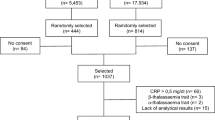Abstract
Background
Subclinical micronutrient deficiencies have been gradually becoming more important as a public health problem and drawing attention of the health authorities. Today it has been known that detecting and treating people having deficiency symptoms alone is no longer sufficient. It is important to detect and prevent any deficiency before it displays clinical manifestations. Zinc deficiency is one of the most widespread micronutrient deficiencies. In this study, we aimed to evaluate the zinc status and the associated factors in healthy school-age children.
Methods
The study was carried out in schools in Altindag, the district of Ankara. A total of 1063 healthy children, 585 girls and 478 boys, aged 5–16 years were included in the study. Serum zinc, high-sensitivity C-reactive protein levels and white blood cell count were measured. A serum zinc level <65 μg/dL was considered as subclinical zinc deficiency for children <10 years of age. For children ≥10 years of age the cutoffs for serum zinc concentration were set at 66 μg/dL for females and 70 μg/dL for males. A questionnaire was developed to collect socioeconomic and demographic information of the participants.
Results
The prevalence of subclinical zinc deficiency in children attending the study was detected to be 27.8%. This high ratio showed zinc deficiency was an important health problem in the Altindag district of Ankara, Turkey.
Conclusions
Evaluating the indicators of zinc deficiency such as serum zinc concentration, dietary zinc intake and stunting prevalence, this study is the most comprehensive epidemiological study performed in children in Turkey. This study reveals the high prevalence of subclinical zinc deficiency and indicates that zinc deficiency is a public health concern for the study population.
Similar content being viewed by others

References
Bailey RL, West KP Jr, Black RE. The epidemiology of global micronutrient deficiencies. Ann Nutr Metab 2015;66 Suppl 2:22–33.
Underwood BA. Perspectives from micronutrient malnutrition elimination/eradication programmes. Bull World Health Organ 1998;76 Suppl 2:34–37.
International Zinc Nutrition Consultative Group (IZiNCG), Brown KH, Rivera JA, Bhutta Z, Gibson RS, King JC, et al. International Zinc Nutrition Consultative Group (IZiNCG) technical document #1. Assessment of the risk of zinc deficiency in populations and options for its control. Food Nutr Bull 2004;25:S99–S203.
de Benoist B, Darnton-Hill I, Davidsson L, Fontaine O, Hotz C. Conclusions of the joint WHO/UNICEF/IAEA/IZiNCG interagency meeting on zinc status indicators. Food Nutr Bull 2007;28:S480–484.
Zinc in Soils and Crop Nutrition, 2008. http://www.zinc.org/wpcontent/ uploads/sites/4/2015/01/2008_IZA_IFA_ZincInSoils.pdf (accessed November 21, 2016).
Hotz C, Peerson JM, Brown KH. Suggested lower cutoffs of serum zinc concentrations for assessing zinc status: reanalysis of the second National Health and Nutrition Examination Survey data (1976-1980). Am J Clin Nutr 2003;78:756–764.
Chenillot O, Henny J, Steinmetz J, Herbeth B, Wagner C, Siest G. High sensitivity C-reactive protein: biological variations and reference limits. Clin Chem Lab Med 2000;38:1003–1011.
Nicholson JF, Pesce MA. Laboratory medicine, drug therapy, and reference tables. In: Jenson HB, eds. Nelson textbook of pediatrics. Philadelphia: Saunders Company, 2004: 2398–2421.
Wapnir RA. Zinc deficiency, malnutrition and the gastrointestinal tract. J Nutr 2000;130:1388S–1392S.
Iavicoli I, Carelli G, Stanek EJ 3rd, Castellino N, Calabrese EJ. Effects of low doses of dietary lead on puberty onset in female mice. Reprod Toxicol 2004;19:35–41.
Villalpando S, Garcia-Guerra A, Ramirez-Silva CI, Mejia-Rodriguez F, Matute G, Shamah-Levy T, et al. Iron, zinc and iodide status in Mexican children under 12 years and women 12-49 years of age. A probabilistic national survey. Salud Publica Mex 2003;45 Suppl 4:S520–S529.
Karr M, Mira M, Causer J, Earl J, Alperstein G, Wood F, et al. Plasma and serum micronutrient concentrations in preschool children. Acta Paediatr 1997;86:677–682.
Thane CW, Bates CJ, Prentice A. Zinc and vitamin A intake and status in a national sample of British young people aged 4-18 y. Eur J Clin Nutr 2004;58:363–375.
Laitinen R, Vuori E, Dahlstrom S, Akerblom HK. Zinc, copper, and growth status in children and adolescents. Pediatr Res 1989;25:323–326.
Duque X, Flores-Hernandez S, Flores-Huerta S, Mendez-Ramirez I, Munoz S, Turnbull B, et al. Prevalence of anemia and deficiency of iron, folic acid, and zinc in children younger than 2 years of age who use the health services provided by the Mexican Social Security Institute. BMC public health 2007;7:345.
Al-Timimi DJ, Al-Sharbatti SS, Al-Najjar F. Zinc deficiency among a healthy population in Baghdad, Iraq. Saudi Med J 2005;26:1777–1781.
Donangelo CM, Azevedo CE. Serum zinc in Brazilian children of families of low income. Arch Latinoam Nutr 1984;34:290–297. [In Portuguese]
Lockitch G, Halstead AC, Wadsworth L, Quigley G, Reston L, Jacobson B. Age-and sex-specific pediatric reference intervals and correlations for zinc, copper, selenium, iron, vitamins A and E, and related proteins. Clin Chem 1988;34:1625–1628.
Thurlow RA, Winichagoon P, Pongcharoen T, Gowachirapant S, Boonpraderm A, Manger MS, et al. Risk of zinc, iodine and other micronutrient deficiencies among school children in North East Thailand. Eur J Clin Nutr 2006;60:623–632.
Vaghri Z, Barr S, Wong H, Chapman G, Hertzman C. Age-based differences in hair zinc of Vancouver preschoolers. Biol Trace Elem Res 2008;126 Suppl 1:S21–S30.
WHO Child Growth Standards. http://www.who.int/childgrowth/ en/index.html (accessed November 20, 2016).
Wieringa FT, Dijkhuizen MA, West CE, Northrop-Clewes CA, Muhilal. Estimation of the effect of the acute phase response on indicators of micronutrient status in Indonesian infants. J Nutr 2002;132:3061–3066.
Author information
Authors and Affiliations
Corresponding author
Rights and permissions
About this article
Cite this article
Vuralli, D., Tumer, L. & Hasanoglu, A. Zinc deficiency in the pediatric age group is common but underevaluated. World J Pediatr 13, 360–366 (2017). https://doi.org/10.1007/s12519-017-0007-8
Received:
Accepted:
Published:
Issue Date:
DOI: https://doi.org/10.1007/s12519-017-0007-8


